PORT AUTHORITY THEATER
ride aloft with cameramen for an exciting
new look around New York's vast waterfront
|
THE TOWERING PILLARS of the
Heliport at the Fair, operated by Port of New York Authority,
shelter the 195-foot circumference of a circular theater in which
another spectacular 360-degree color film surrounds the audience
with the Port-sponsored film, From Every Horizon.
This 12-minute "stereo" picture, produced by Fred
A. Niles Communications Centers, rides above and around the far-flung
facilities of this great port, shows its bridges and tunnels
as they funnel millions of people back and forth from suburbia
to the working canyons of Manhattan each day. It takes viewers
aloft in its many helicopter-shot sequences to show how the Port's
international trade operations -- docks and airports -- play
such an important part in the commerce of the area.
|
|
Beneath this Port Authority Heliport is the
circular theater in which Fairgoers see "From Every Horizon,"
a 360-degree look at the Port.
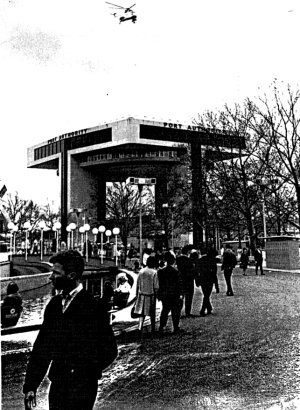 |
|
|
Niles' crews produced the film with a specially-designed rig
of 10 Arriflex 16mm cameras, matching their "takes"
to the ultimate 10-screen projection setup which envelopes viewers
in the circular "stand-up" theater (see sketch below).
The camera setup was trundled all over the Port area by special
vehicle and, most notably, taken aloft by helicopter to give
the Fair viewers some very exciting moments as the whole viewing
area and tilting horizon make him feel part of the action.
Projection is via a "pod" suspended in the center
of the theater's ceiling. In this booth, 10 Eastman Kodak Model
25 16mm sound projectors were setup by William Ralke for synchronous
operation. Each has a 36-degree field of view to cover its section
of the 10 screen panels which encircle the auditorium.
Narration has a "stereo" effect as voices come from
the "Jersey" side of the Hudson River seen on the screen
and, again, from the New York side, thus emphasizing the bi-state
nature of the Port Authority to the audience.
|
Left: Sketch of the 10-screen
theater. Right: Many of the scenes in "From Every Horizon"
were lensed by Niles' crews from helicopters; our picture caught
only three of ten screens which enfold viewers, to show one of
bridges along New York waterfront.
 |
Source: BUSINESS
SCREEN MAGAZINE Presented courtesy Eric Paddon Collection
|
Port Authority picture is shown in this
circular theater beneath the Heliport (background); there is
no admission charge to this program.
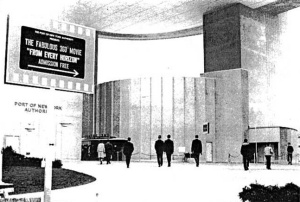
|
|
|
The Port's "Theater 360" is now
drawing good audiences at nearly all performances as this entrance
shot of a typical waiting line proves.
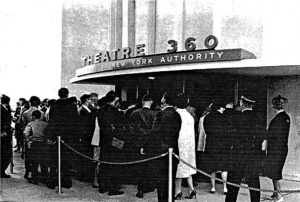
|
|
|
A special rig of 10 16mm Arriflex
motion picture cameras filmed 360°
movie now showing at World's Fair.
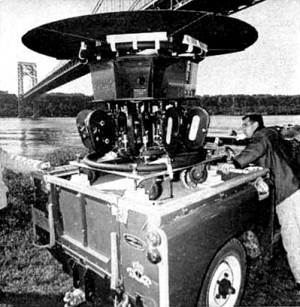 |
Ten Kodak Model 25 projectors
are used to present the movie. They are suspended from the theater's
ceiling.
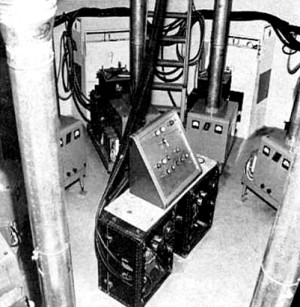 |
|
-
The Port Authority's
-
Widest-Screen Movie
You can't get any wider than 360 degrees
of wrap-around projection surface on which is seen this World's
Fair film.
|
The Port of New York Authority's piece de resistance at the
Fair is a wide-screen movie. In fact, you can't get any wider
than the 360 degrees of wrap-around projection surface on which
is seen "From Every Horizon."
This 13-minute sound and color film gives viewers the feeling
of "going along" on a trip around the New York-New
Jersey port. It is beamed by 10 projectors on a screen 13 1/2
feet high and 195 feet around in a 60-foot-diameter theater in
the Port of New York-New Jersey Exhibit Building.
The motion picture is being given continuous performances
to audiences of up to 400 standees -- and we don't mean people
left over after all the seats are taken. There are no seats in
the Port Authority theater, since standing is the only comfortable
way to look at a screen that completely surrounds the viewer.
The screen is about seven feet off the floor, and people wander
about looking at various aspects of the scenes.
The special projection equipment was developed by the Ralke
Company of Los Angeles. it is housed in a pod hung from the ceiling,
so that there is no center obstruction.
|
|
Source: Industrial
Photography, Volume 13 No. 5, May 1964
|
Obviously, such a production presented problems beyond those
associated with a conventional film. The producers, Fred A. Niles
Communications Centers, had to "think circles" instead
of rectangles in their staging, and come up with a camera that
would shoot the same way.
For help in solving the latter problem, they called on a fellow
Chicago organization, Behrend's, Inc, motion picture equipment
specialists. Between them, they came up with an $80,000 camera
rig with "eyes in the back of its head" and which "does
it with mirrors."
The 800-pound rig, 40 inches high and 40 inches in diameter,
consists of 10 16mm Arriflex cameras mounted on a circular metal
frame so that their lenses point not outwards but rather upwards
into 10 circularly aligned mirrors canted at a 45-degree angle
-- somewhat the principle of a periscope.
The problems that had to be overcome in building the camera
were enormous. All 10 cameras had to run in perfect synchronization
with one another, which meant that all shutters had to continuously
open and close at the same instant.
Further, theoretically, the only way a 360-degree film can
be made to show objects moving smoothly at three feet as well
as at infinity is to have all 10 lenses molded together at one
central point, the nodal point. Since this is physically impossible,
that's where the mirrors came in. The mirrors are used to "fold"
the light. This makes it possible for all 10 lenses to have one
nodal point, yet be in different positions.
The mirrors had to be adjusted precisely to avoid a horizontal
staggering effect when the 10 images are projected. Any misalignment
would be magnified tens of thousands of times on the 13 1/2-foot-high
screen.
Close Tolerances
For the same reason, the cameras had to be positioned on the
rig at tolerances within .00025 of an inch. These tolerances
had to be maintained even though the cameras had to be periodically
removed from the rig to unload and load the 400-foot film magazines
-- with no time for adjustments when they were snapped back on
-- and even though they received considerable knocking about.
The script called for the camera to be mounted on a barge, a
truck and a helicopter and under the belly of a jet plane taking
off. For another scene, it teetered atop the George Washington
Bridge.
Automatic Cutoff
The rig is designed so that if something goes wrong with one
of the cameras, an electronic signal is sent to a control box,
which automatically shuts off the entire rig. A light on the
box indicates which camera is the culprit. All in all, it's quite
a unit.
|
Source: Arriflex
Advertisement, Industrial Photography, Volume 13 No. 5,
May 1964
|
Above: Camera rig is mounted to helicopter.
Top Right: Filming over the Hudson River. Right: Close-up of Arriflex
Camera Rig.
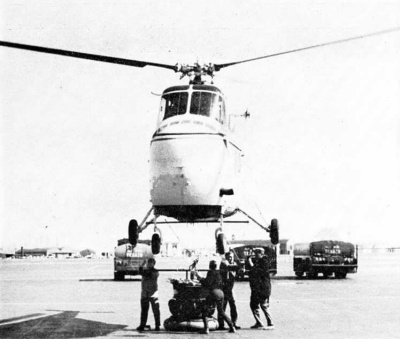 |
- ARRIFLEX®
goes 360° panoramic
- for New York Port Authority World's Fair
Film
|
|
|
|
Shooting from helicopters, rafts
on the Hudson River, atop the George Washington Bridge -- even
from underneath a jet plane -- cameramen of Fred A. Niles Communications
Centers, Inc., completed a most unique motion picture, the 360° ultra-spectacular
panorama for the Port of New York Authority's exhibit at the
World's Fair! Designed to be shown on a complete circle screen,
the 12-minute film dramatically emphasizes how PA transportation
facilities serve 14,000,000 people in the New York Metropolitan
area.
Behrend's Inc., Chicago motion
picture equipment specialists -- with the aid of Niles technicians
-- engineered a suitable "camera" for the stupendous
project. They mounted 10 Arriflex 16M's (equipped with 400-ft.
magazines) on a rigid steel frame, with each camera precisely
set to shoot up into one of
|
10 circularly arranged mirrors.
Problems of holding to .0025-inch camera-position tolerance,
exact phasing, intricate image-angles, optical exactitude and
parallax correction -- to name but a few -- were ingeniously
solved.
A gear-interlock mechanism connected
all the drive shafts of the 10 Arriflexes for identical 24 fps
operation. Of special significance in the selection of the Arriflex
"M" are its gear-driven magazine system, register pin
film movement, small size and weight, combined with its high
adaptability and absolute reliability.
In this imaginative and demanding
motion picture assignment, Arriflex again proved its versatility
as an instrument of almost limitless capability. It will answer
your filming needs as well.
|
|
|